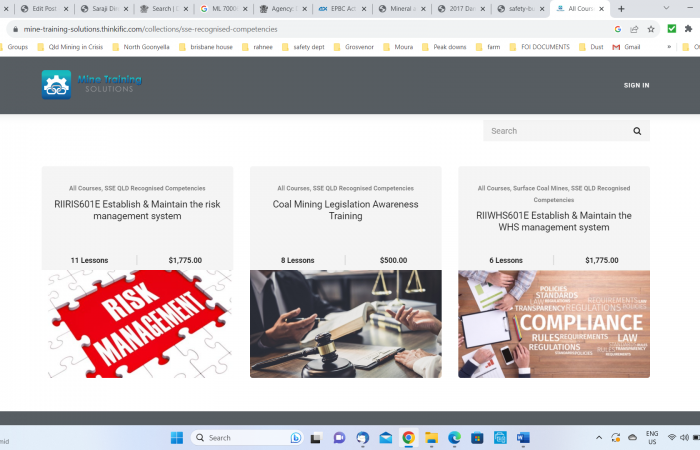
Draft Coal Mining Legislation Changes for Employing Statutory Officials in Queensland. Has anyone seen it?
The changes deal with the Employment arrangements of Statutory Officials including Site Senior Executives, Underground Mine Managers, Ventilation Officers, ERZ Controllers (Deputies) and Open Cut Examiners.
I understand the Coal Mining Companies have had a Consultation Draft of changes to the Coal Mining Act/Legislation for around a month.
I have searched on the RSHQ and State Government websites and cannot find a thing.
I cannot and do not understand why a Consultation Draft changes to the Act would not be made public.
Otherwise who is being consulted?
The QRC? BMA? Anglo?
Has anyone from the Production and Engineering workforce actually seen it and if so were you given a copy?
Ten Pathways to Death and Disaster: Learning from Fatal Incidents in Mines and Other High Hazard Workplaces by Michael Quinlan (pg 212)
Once findings and recommendations are handed down the next hurdle is the extent to which the government agrees to implement all or some of the recommendations.
A range of factors can affect this, including
- the lapse of time (usually a year or more has passed since the incident),
- the level of community pressure, the government’s own policy agenda and the implementation process itself in terms of those given input,transparency, time-lines etc.
- Ministerial and Cabinet approval for substantial legislative change is commonly subject to intense lobbying by influential interest groups seeking to block or water down the legislation in a discreet fashion.
- Such activity is seldom reported.
On the other hand, those in favour of the change will need to scrutinise the regulatory drafting to ensure the legislation will actually achieve its purpose.
Key appointments to legislative oversight bodies and within the public sector can act as either lubricants or sources of friction with regard to the reform process.
The legislative drafting can be critical.
Even seemingly minor revisions can have significant effects. Equally critical is the provision of adequate infrastructure like inspectorate resourcing and strategic direction to implement the changes.
Even when regulatory change is successfully introduced powerful interest groups often seek to influence its implementation, to lobby their political representatives to reverse legislation or undermine its enforcement, or to refashion the laws years later when the heat has gone out of the debate



Ten Pathways to Death and Disaster: Learning from Fatal Incidents in Mines and Other High Hazard Workplaces by Michael Quinlan (pg 212)
Once findings and recommendations are handed down the next hurdle is the extent to which the government agrees to implement all or some of the recommendations.
A range of factors can affect this, including
the lapse of time (usually a year or more has passed since the incident),
the level of community pressure, the government’s own policy agenda and the implementation process itself in terms of those given input,transparency, time-lines etc.
Ministerial and Cabinet approval for substantial legislative change is commonly subject to intense lobbying by influential interest groups seeking to block or water down the legislation in a discreet fashion.
Such activity is seldom reported.
On the other hand, those in favour of the change will need to scrutinise the regulatory drafting to ensure the legislation will actually achieve its purpose.
Key appointments to legislative oversight bodies and within the public sector can act as either lubricants or sources of friction with regard to the reform process.
The legislative drafting can be critical.
Even seemingly minor revisions can have significant effects. Equally critical is the provision of adequate infrastructure like inspectorate resourcing and strategic direction to implement the changes.
Even when regulatory change is successfully introduced powerful interest groups often seek to influence its implementation, to lobby their political representatives to reverse legislation or undermine its enforcement, or to refashion the laws years later when the heat has gone out of the debate